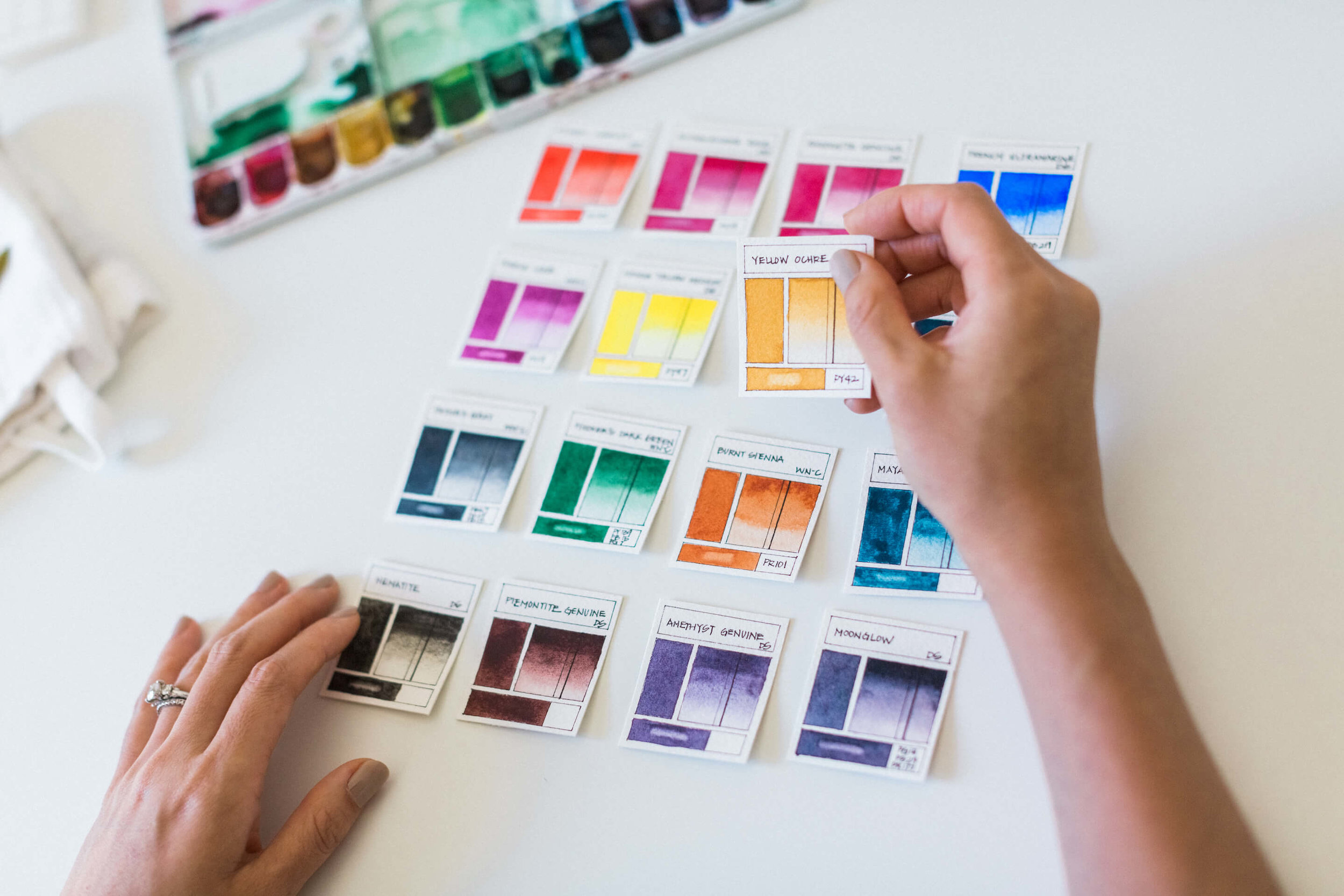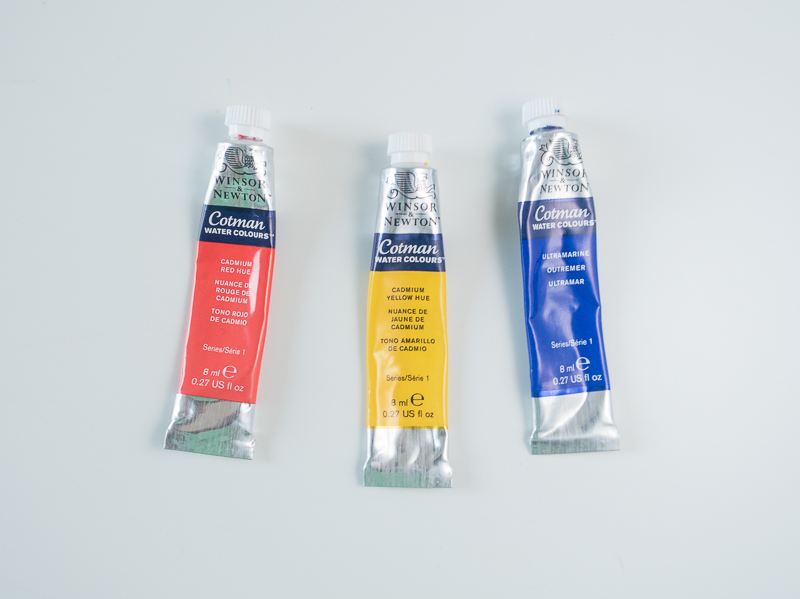Which Watercolor Paints and Colors to Buy?
One of the questions that I get asked the most is what type of paints I use. I have to start by saying that I can't recommend the best and only paints to use because these really come down to personal preference at the end of the day - like most things in life. But, what I can do, is share with you what my preferences are, based on my experiences.
Now, if you’re looking for someone who has tested out a bunch of paints from a bunch of different brands and is here to lay out all the nitty gritty details and comparison notes for you…you probably should stop reading right now.
I don’t own all the supplies and I try hard not to acquire more than I need, so I am not an expert on different brands of paints. I like to keep things simple. I do the research, ask artists I trust, and buy what I need.
This post is going to be simple and to the point. The hope is that this provides enough information that you feel confident in making a purchase and moving onto the more important stuff: actually painting!
Color swatches of some of my paints. Photo by: Ragi and Amanda
So I’m going to make it really easy. There are a TON of factors when it comes to paints, but for now let’s just go over two decisions you need to make:
Decide on tubes or pans
If tubes, decide on the colors you want
1. TUBES or PANS?
Do you want to buy watercolor in pans or in tubes? Below are some good and bad points to consider with both:
Tubes
Allow you to mix and match, but also come in sets, like this or this.
You can decide on your own palette (where you have a lot of choices too!) Here’s are some palette examples you can choose from:
Folding Plastic Palette (this is my favorite)
Folding Aluminum Palette (like this)
Palette with empty pans you fill yourself (I have the Tin with 12 half pans for travel)
Big Studio Palette (never tried myself, but like this)
Butcher Tray (which I’ve been curious to try)
A dinner plate
Not stuck with only one palette: you could buy multiple palettes and fill them with your tube colors. For example, I have a palette I use at home (#1), and a different palette I use for travel (#3).
It's easy to go overboard buying colors - which can get expensive!
Pans Sets
Typically always come in sets so you don’t need to decide what colors to buy
Easy to travel with and compact
Tend to have less room for mixing within the palette itself (because the palettes are small)
Sometimes smaller pan sizes in the sets mean easier cross contamination between colors - although not a huge problem in my opinion, depends if you use larger brushes vs smaller brushes in your painting style
Here two pan sets that you might want to look into:
Van Gogh 12 pan set (I have one like this from college)
Winsor & Newton Cotman Watercolor Set (like this)
Suggestion: You could start with a pan set if you don't want to commit to tubes and then use it as your travel palette later!
My PREFERENCE: Tubes + Folding Plastic Palette
I like to buy tube paints and fill my empty palettes with colors. I just fill the wells in the palette with paint and let it dry. I don’t like to fill each well in the palette completely full, maybe just one good squeeze.
TIP #1
Wash your brand new palette with baking soda. Using baking soda will help prep the plastic (or aluminum) for your paint and prevent the dried paint from falling out of the palette - which sometimes happens with new palettes because of the slick surface. In the mixing areas, this helps water and pigment mix easier and prevent beading of the liquid on the palette.
TIP #2
Let the paint dry overnight before using. Letting the tube paint dry in your palette and then rehydrating it when you paint will save paint. If you use the paint out of the tube when it’s wet, you’ll end up unintentionally using more paint that you need!
FREE BONUS: WATERCOLOR SUPPLY GUIDE + CHECKLIST
I put together a helpful buying guide and checklist to help you overcome supply overwhelm! Enter your information below to download it!
About Paint Grades: Student vs. Professional Grade
There are a few differences between student grade and professional/artist grade watercolor paints. In short, what you need to know is that student grade paints have more filler and less pigment in the mix. In addition, many of the student grade pigments do not use real pigments like the professional grades. And finally, the lightfastness (ability to resist fading over time) is better in artist grade paints.
That being said, Winsor & Newton Cotman series tube paints often have decent lightfastness ratings and in my experience, you can get just as good of a color payoff as artist grade. These are the tube paints I started with and was able to find them at my local art store, Michaels.
Here’s a summary of points on student grade vs. professional grade paints:
Student grade generally has more filler, so less pigment and more binder. This means that you will need to use more student grade paint to get the same color payoff as a professional grade paint.
The word “hue” in student grade paints often indicates less pigment concentration in the color. If you happen upon the word "hue" in professional grade paints, it doesn't mean the same thing though! Here's a more in depth summary of the word 'hue' as used in paint products - if you want to read up on it.
Lightfastness is better with professional grade paints - this is important if you’re selling original art work, as it should resist fading over time. As a beginner or hobby painter, this is not as big of a deal.
My Preferred Student Grade Tube Paints:
Winsor & Newton Cotman
My Preferred Professional Grade Tube Paints:
Daniel Smith Extra Fine Watercolors
2. What colors to pick and how many?
Assuming you're going with tubes and a palette, you'll need to decide how many colors to start off with. Here's what I recommend:
If your budget is really tight, start with 3
If you can afford it, try getting 6
If you’re really enthusiastic, get 12
Here are my choices in both student grade (Winsor & Newton Cotman) and professional grade (Daniel Smith) for 3, 6, and 12 color palettes:
3 Color Palette
Winsor & Newton Cotman
Cadmium Red Hue
Cadmium Yellow Hue
Ultramarine
Daniel Smith
Pyrrol Scarlet
Hansa Yellow Medium
French Ultramarine (or Ultramarine)
6 Color Palette
Winsor & Newton Cotman
Cadmium Red Hue
Cadmium Yellow Hue
Ultramarine
Sap Green
Burnt Sienna
Purple Lake
Daniel Smith
Pyrrol Scarlet
Hansa Yellow Medium
French Ultramarine (or Ultramarine)
Sap Green
Burnt Sienna
Quinacridone Rose
12 Color Palette
Winsor & Newton Cotman
Purple Lake
Cadmium Red Hue
Lemon Yellow Hue
Cadmium Yellow Hue
Ultramarine
Cerulean Blue Hue
Sap Green
Hookers Green (light or dark)
Burnt Sienna
Yellow Ochre
Burnt Umber
Paynes Grey
Daniel Smith
Quinacridone Rose
Pyrrol Scarlet
Hansa Yellow Light
Hansa Yellow Medium
French Ultramarine (or Ultramarine)
Cerulean Blue Chromium
Sap Green
Phthalo Green
Burnt Sienna
Quinacridone Gold (mine is WN)
Raw Umber
Paynes Grey
There is a lot more detail that goes into colors and pigments including: opacity/translucency, staining, granulation just to name a few but when you’re just starting out don’t let yourself get weighed down by the other technicalities, you can learn those as you go. The most important thing is to get some reliable paints and start painting. I have used all of the above and feel like they are great place to start. If you’re worried, just buy a few tubes and add on as you go.
If you are looking for a summary and even more straightforward way to get started with supplies and painting, download my free supply guide here!
If you find yourself lost with what to do after you have all your paints and palette set up, try making a color chart of your palette or dive into mixing colors by painting a color wheel!
Hope this was helpful - as always thank you for reading!
Susan
*Disclosure: Some links contained in this post are affiliate links, which means that if you click on one of the product links, I’ll receive a small commission. Your cost remains the same - thank you for the support!









